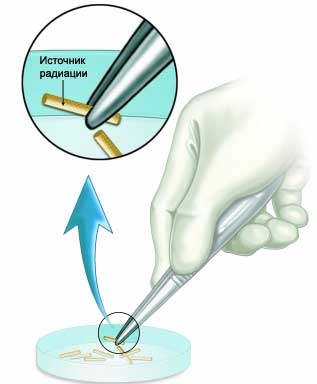Radiation therapy is internal - Brachytherapy
Description brachytherapy
Radiation therapy is used to treat cancer and other diseases. This method of treatment uses high-energy particles, to damage the genetic code (DNA) in cancer cells. After that abnormal cells lose their ability to grow and divide.
There are two main types of radiation therapy:
- Source of external radiation – apparatus, which emits radiation on cells and is outside the body;
- Radioactive materials are introduced into the body and delivered to the cancer cells (brachytherapy).
In some cases, your doctor may recommend a combination of these methods. Radiation therapy is often used in conjunction with other treatments, such as surgery, chemotherapy and immunoterapiya (It stimulates the immune system to fight infection).
The following describes the use of internal radiation therapy.
The reasons for using brachytherapy
- Control the growth or spread of cancer;
- Trying to cure cancer;
- Reduce pain or other symptoms, caused by cancer (This is called palliative treatment).
Radiotherapy is widely used for the treatment of various tumors, such as prostate cancer, breast cancer, and head and neck cancer.
Possible complications of treatment with internal radiation therapy
Internal exposure may cause side effects, as the radiation damages your own healthy cells together with cancer.
Side effects may vary, depending on the type and location of treatment. The most common side effects that may occur (side effects from treatment may also be other):
- Fatigue;
- Skin changes (redness, irritation);
- Reduced number of leukocytes in the blood;
- Hair loss;
- Nausea, vomiting, or diarrhea;
- Loss of appetite.
Discuss the specific side effects can be a doctor.
Factors, that may increase the risk of complications include:
- Previous radiation therapy;
- Patient: lupus, scleroderma, dermatomyositis.
Women, who are pregnant or may be pregnant should avoid exposure. This may cause irreparable harm to the developing fetus.
How is internal radiotherapy?
Preparing for treatment
Anesthesia
The patient may need local anesthesia, which numb a small area of the body, or general anesthesia, during the term of which the patient is asleep.
Procedure internal radiation therapy
The radiation source is placed directly in the patient's body in or near the cancerous site. This provides a high dose of radiation in a short time. The radioactive source (Cesium, iridij, palladium, or iodine) It may be in the form of a wire, pellets or rods.
This procedure is primarily used for the treatment of head and neck cancer, Breast, uterus, Thyroid, cervical and prostate.
The main types of internal radiation:
- Interstitial brachytherapy – granules, needle, or wires placed inside the affected tissue in short term or on a permanent basis;
- Intracavitary brachytherapy – a container with radioactive material is placed temporarily into the body cavity – the uterus, vagina, or airways (usually trachea).
How long will the internal radiotherapy?
The time depends on the type of cancer, treatment and methods of internal exposure.
Will it hurt when internal radiation therapy?
Anesthesia prevents pain during the procedure. The patient may experience pain during recovery whichever, where he was placed radioactive material.
The average hospital stay
The patient remains in the hospital until, while the implant is removed, or, in the case of a permanent implant, when the radioactivity has decreased.
Doctors usually remove implants with high doses of radiation for a few minutes. Implants with low dose radiation can remain in the body for several days. Permanent implants lose their activity for several days.
Care after internal radiation therapy
Be sure to follow your doctor's instructions.
After the implant patient in a hospital ward. The patient must take precautions to prevent the exposure of other people.
Seen Limited
Many hospitals do not allow children under the age of 18 and pregnant women to visit a patient, having radiation implants. They can visit him only after, as the implant is removed. If visitors are allowed, they must be located at least two meters away from the bed with the patient. Visit the limited time 10-30 minutes.
The hospital staff can place a special panel next to the bed, to protect visitors and staff from radiation.
Limited contact with the staff
The hospital staff communicate with patients at a distance (perhaps even without going to the Chamber). They may also come and go very quickly, to avoid excessive exposure to radiation.
During treatment, the patient visits the doctor at least once a week. They can be assigned to routine blood tests to check the effects of radiation on the blood cells.
After completion of treatment the patient will have to make regular examinations, to evaluate its effectiveness. Follow-up will be different for each person.
Further care may include testing, medications or medical rehabilitation.
You should inform your doctor, If any side effects. Many side effects can be treated with medication or diet. Your doctor may change or delay the course of treatment, if the side effects are too much or they threaten the health of. Most side effects gradually take place after treatment.
Hazardous situations after internal radiation therapy
After treatment and return home need to see a doctor if you experience these problems:
- There are signs of infection, including fever and chills;
- Diarrhea or loss of appetite;
- Unexplained weight loss;
- Frequent urination, especially if it is accompanied by pain and burning;
- There are new tumor;
- Nausea and / or vomiting, which do not disappear after taking the prescribed medicines;
- Pain, which persists for a long time;
- Unusual changes in the skin, including bruising, rash, discharge or bleeding;
- Cough, shortness of breath or chest pain;
- Ugly symptoms, the possible occurrence of which can alert the doctor;
- Any unknown danger signs.
In the case of a serious and rapidly deteriorating health should immediately call an ambulance.

